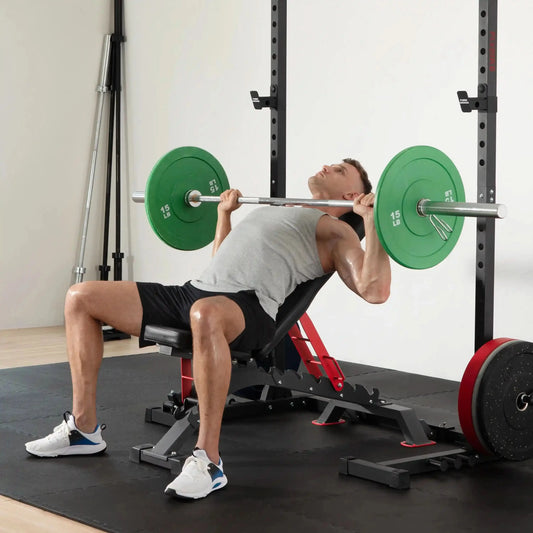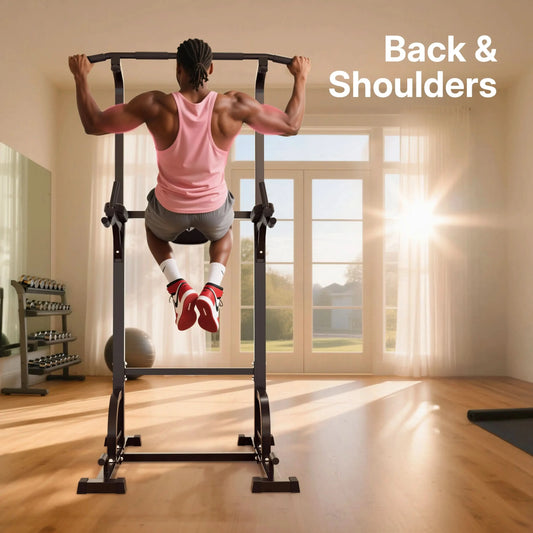Many beginners have heard of the bench press but aren’t sure what it is, what it does, or how to practice it. This article explains the movement in simple steps, shows you which muscles it trains, and outlines the benefits for strength, muscle, and daily life.
What Is Bench Press, And Why Is It Important To Beginners?
The bench press is essentially a free-weight push exercise, performed on a
weight bench. Lie on a firm bench with your feet firmly planted on the floor. Contracting your shoulder blades, lower the weight to mid-chest, keeping your forearms perpendicular to the ground. Pause, then press upward. It is the most common technique taught by coaches as it is a balance of power and joint safety. This is a compound exercise that involves the shoulder, leg, and elbow joints, making it very effective for whole-body strength and muscle development.
To the novice, the bench press will teach you to maintain a tight back, but to coordinate the chest, shoulders, and triceps. It is also an easy method of tracking improvement week by week. When the range of motion is not pain-free, begin with smaller dumbbells and a small range. Shoulder pain: In case you are experiencing shoulder pain, consult a competent clinician before loading the lift.
Which Muscles Does The Bench Press Work Most?
The bench press primarily trains the pectorals, triceps, and front deltoids. Several stabilizers keep you tight and safe during the set.
- Chest (pectoralis major): drives the press off the chest.
- Triceps brachii: extends the elbows and secures the lockout.
- Anterior deltoids: assist pressing; guide bar path.
-
Lats and upper back (scapular retractors): keep the shoulder blades braced on the pad.
- Core and legs: create a firm base so the upper body can press hard without losing position.
Because multiple muscle groups fire at once, you get more strength and muscle return per minute than many single‑joint movements. That’s a key reason the bench press appears in powerlifting alongside the squat and deadlift.
What Are The Key Benefits Of Bench Press For Strength And Health?
The lift provides a reliable pathway to stronger pushing, more muscle across the chest and arms, and improved performance in throwing, grappling, and contact sports. When included in a balanced resistance‑training program, pressing strength supports everyday tasks like pushing heavy doors or lifting boxes to a shelf.
Moreover, resistance training as a whole can help maintain or improve bone mineral density, especially in adults who need it most. Meta‑analyses show meaningful improvements in lumbar spine and hip bone density with well‑planned resistance training, with programs at moderate to higher intensities and training three times per week, performing well in several reviews. While the bench press itself is just one exercise, it fits into upper‑body programs that support these outcomes.
From a training economy standpoint, few exercises let you load safely and progress in small, measurable steps like the bench press. That makes it a cornerstone for both beginners and intermediate lifters who want steady improvements without overly complex routines.
How Do You Set Up The Bench Press Safely At Home Or In The Gym?
A good setup creates strength and safety before the first rep.
-
Rack and safeties: Set J‑cups so you can unrack without shrugging. Place safeties just below chest height so clean reps clear the pins, but a failed rep rests on them if needed.
-
Bench position: Center the bench in the rack; lie so your eyes start under the bar.
-
Foot placement: Plant feet flat or on the forefoot with firm pressure; no shifting during reps.
-
Upper‑back tension: Retract and depress the shoulder blades to lock them to the pad.
-
Grip: Use a closed, full thumb grip. Choose a width that leaves the forearms vertical at the bottom.
If you train at home, invest in a stable, adjustable bench that locks securely and fits your space. For compact, foldable options with multiple backrest angles, explore Flybird’s weight‑bench lineup:
Weight Benches – Home Gym Workout Benches.
When pressing with a spotter, agree on “ready, liftoff, rack” before you start. For over‑the‑head barbell lifts like the bench press, NSCA guidance stresses an alternated grip when assisting and clear communication so the spotter helps only when necessary.
How Do You Do The Bench Press Step By Step With Proper Form?
Clean execution protects your shoulders and builds strength where you need it.
Approach and setup
- Lie back with eyes under the bar.
- Plant feet and create full‑body tension.
- Retract and depress the shoulder blades.
- Grip the bar evenly; wrists stacked over forearms.
Unrack and settle
- Press the bar out of the hooks to locked elbows.
- Bring it over the shoulder joint; take a calm breath.
Lower with control
- Keep elbows at roughly 45–70 degrees relative to the torso.
- Lower to touch mid‑chest lightly—no bounce.
Press to lock out
- Drive through the floor, keep wrists neutral, and press slightly back toward the rack in a gentle “J” path.
- Finish with elbows straight, then repeat.
Common cues that help
- “Bend the bar” to set the lats.
- “Chest up” to maintain a stable arch.
- “Push the floor” to keep leg drive.
Kinematic research suggests bar path and joint angles change slightly by grip width, and heavier loads can increase shoulder joint moments—especially with wider grips—so build load gradually and keep your technique consistent rep to rep.
Which Bench Press Variations Should You Try As You Progress?
Variation keeps progress moving, lets you bias different regions of the chest and triceps, and reduces overuse.
-
Incline barbell or dumbbell press (15–30°): Shifts more work to the upper chest; higher angles beyond 45° emphasize the anterior deltoid and reduce pectoral contribution.
-
Decline press: Targets the lower chest and may feel friendlier on some shoulders due to a different humeral path.
-
Close‑grip bench press: Increases triceps demand and helps the lockout phase. Grip‑width studies also show changes in elbow and shoulder loading patterns, so adjust slowly.
-
Dumbbell flat press: Increases range of motion and stability demands; a good choice if one shoulder prefers a slightly different path than the other.
Rotate one variation for 6–8 weeks at a time while keeping a flat bench day in the week if strength on the core lift is your priority.
What Mistakes Cause Most Bench Press Plateaus And Aches?
Technical slips are common and usually easy to fix.
Loose upper back and shifting feet
Solution: Set your shoulder blades “back and down,” keep contact with the pad, and maintain firm foot pressure throughout the set.
Elbows flaring too early or bar drifting toward the neck
Solution: Touch mid‑chest and keep wrists stacked over elbows.
Bouncing the bar or an inconsistent touch point
Solution: Control the descent and make a light, repeatable chest touch at the same spot each rep.
Bent wrists or a “thumbless” grip
Solution: Place the bar across the mid‑palm and wrap the thumb securely for better force transfer.
Over‑wide grip with heavy loads when the shoulders are irritated
Solution: Temporarily narrow your grip and emphasize scapular retraction; recent modeling work shows narrower grips and retracted scapulae can reduce acromioclavicular compression and glenohumeral shear forces.
How Should You Program Bench Press Sets, Reps, And Frequency For Your Goals?
Your best plan depends on your training age and goal, but a few principles are consistent across evidence‑based guidelines.
-
Frequency: Most lifters bench 1–3 times per week. Novices often progress well in 2 days. That schedule balances practice, recovery, and weekly volume.
-
Strength focus: 3–5 sets of 3–5 reps with longer rests (2–4 minutes). Progress small—2–5 lb increases—when all reps are clean.
-
Hypertrophy focus: 3–5 sets of 6–12 reps with moderate loads and controlled tempo. Accumulate weekly volume without grinding to failure.
-
Beginner linear progression: If all sets look crisp, add a small amount of weight next session. If the technique degrades, hold the weight or step back slightly and repeat.
-
Warm‑up ramp: From the empty bar, take 3–5 ascending warm‑up sets to groove position and check bar path.
These guidelines align with established position stands on resistance training progression for healthy adults. They emphasize planned overload, adequate rest, and gradual increases in training stress.
How Should You Warm Up For Safer, Stronger Sets?
A brief, targeted warm‑up prepares joints and stabilizers without creating fatigue.
- 3–5 minutes of light cardio: brisk walk, cycle, or rope to increase temperature.
- Mobility and activation: band pull‑aparts, scap push‑ups, and light cable or band external rotations.
- Specific ramp‑up sets: 5–10 reps with the empty bar; then 3–5 progressively heavier sets of 3–5 reps until you reach your first work set.
Keep the last warm‑up rep snappy. If a weight feels slow or unstable, add another small ramp step before starting your work sets.
How Do You Stay Safe Training Alone Or With A Spotter?
Safety is built into the setup and your communication.
Training alone
Use a rack with safeties set so the bar would rest on the pins if a rep stalls at the chest. Test pin height with an empty bar so good reps clear, but a failed rep lands cleanly. Never use a thumbless grip.
With a spotter
Agree on commands before the set. The spotter stands close at the head of the bench and uses an alternating grip for liftoff and assistance when needed. Hands hover under the bar without touching unless help is requested or the bar stalls. These standards reflect widely taught NSCA spotting procedures for over‑the‑face lifts.
Shoulder‑friendly habits
Maintain a comfortable arch, keep shoulder blades retracted, and avoid painful ranges. If discomfort persists, reduce load, narrow the grip slightly, or use a modest incline temporarily.
How Can FED Fitness Help You Press Safely At Home?
A stable bench is the foundation of every good home setup. If you need a compact, foldable model with multiple back‑rest angles and an 800‑lb rated capacity, the
Adjustable Weight Training Bench is a space‑smart choice for flat, incline, and decline pressing in small rooms. Its 18.5‑inch bench height supports solid leg drive, while the locking mechanism and steel frame keep the base steady for consistent bar paths.
Conclusion
The bench press is still a good method to train upper-body strength and muscle, provided technique and progression are good. You have now understood what is bench press is, the primary muscles used, the advantages of the bench press as supported by research, the safest bench press setup in the home or gym, and clear programming examples in this guide. Maintain the tightness of your shoulder blades, select a grip that positions the wrists above the elbows, and advance loads in small steps. When you exercise at home, a well-built adjustable bench makes it all easier, both in assembly and disassembly, so that your workouts are the same each week. To learn more about equipment and how to do it, visit the weight-bench line of
FED Fitness and choose a model to fit your space and objectives.
What Quick Answers Do Beginners Need About Bench Press?
Short, practical guidance helps you start fast and stay safe.
How much should I bench?
Start light. Master clean sets of 5–8 reps with perfect control. Add 2–5 lb when bar speed and technique stay consistent.
How often should I bench press?
Two days per week work for many beginners. Add a third day only if recovery is solid and progress has plateaued.
Do I need a belt or a wrist wrap?
Not at the start. Dial in the technique first. If loads get heavy and wrists feel stressed, consider supportive wraps and ensure the bar sits across the mid‑palm.
Is the bench press a compound exercise?
Yes. It uses the shoulder and elbow joints together and recruits multiple muscle groups. That’s one reason progress transfers well to sports and daily life.












